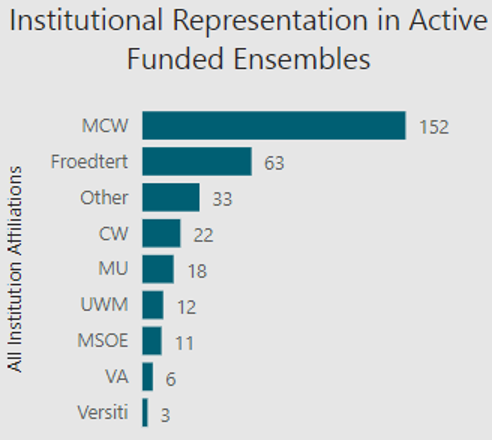Ensemble Program Demographics

Ensemble membership is not limited to only MCW faculty and staff, and participation from our partner institutions and other academic institutions is highly encouraged. While most active team members are associated with MCW, there are members from all eight partner institutions and other academic and community organizations. Of note, because team members can be affiliated with more than one institution, the total number for institutional representation (n=306) is greater than the number of Unique Active Investigators (n=209).
The Ensembles benefit from the participation of a wide variety of MCW departments, divisions, disciplines, and expertise as shown in the figure.
Team members from CTSI Partner Institutions & Other Academic or Community Organizations

Team Member Departmental Representation

Cumulative Institutional and Departmental Representation on Individual Teams
Through inter-institutional networking, the Ensemble Program, since inception, has cumulatively included representation from 38 institutions and 95 unique departments, among all those institutions. Team composition ranges from one to eight institutions per team with an average of two institutions represented on each team. Additionally, an average of five different departments are represented per team, ranging from one to 13 departments per team.

Institution and Department Representation Range and Average for Ensemble Teams

Ensemble Role Representation in the Ensemble Program

The composition of Ensembles includes representation from a diverse collection of members and stakeholders, as shown in the figure, and team members can perform individual or multiple roles in the Ensemble.
Although a team member may fulfill multiple roles, like “wearing different hats,” during team discussions, the individual’s specific contribution to product development is typically defined by a single role. The figure below shows the percentage of each team role represented in the Ensemble Program.

Research Topic and Unmet Medical Needs of Approved Ensembles
The approved Ensembles that formed over the past three years have nucleated around a variety of unmet patient medical needs and are developing a diverse collection of products that range from new medical devices to new software tools, clinical tools, and wearables, to interventions in the clinic, and in the community, and new research through grants, to name a few.
- Atrial Fibrillation & Hypertension: Racial disparities in detection of AFIB & HTN in African-Americans.
- Cardiotoxicity Prediction Tool Using AI: Develop clinical decision aid to assist clinicians in identifying risk for cardiotoxicity in cancer patients.
- Post COVID Tissue Damage: Develop non-invasive biomarkers to predict multisystem organ damage.
- COVID-19 Persistent Effects: Understand COVID-19 rehabilitation across demographics.
- Data Science for Precision Medicine: Lack of a mature data science initiative to improve health outcomes of patients at FMLH.
- Fecal Incontinence: Investigating the efficacy of new medical device in strengthening continence muscles.
- Liver Transplant: Enhance liver resuscitation by developing therapeutic approach to hepatic ischemia reperfusion injury using cold platelets.
- Multiple Myeloma: Develop a biorepository to identify genetic changes unique to Multiple Myeloma, analyzing effects of lifestyle interventions.
- Muslim End-of-Life Healthcare Perceptions: Unmet palliative and hospice care needs of Muslim Americans; knowledge gaps and religious/cultural challenges Muslim Americans face.
- Non-Alcoholic Fatty Liver Disease Screening: Improve outcomes for under-diagnosed NAFLD in communities by utilizing diagnostic point-of-care handheld ultrasound device.
- Obesity & Food Insecurity: Address gaps in knowledge regarding metabolic adaptation’s relationship with weight loss and food insecurity.
- Pediatric ICU/Complex Care: Fill gaps in identifying and allocating resources to critically ill patients & their families to improve health outcomes.
- Preconception to Toddler Health: Bidirectional education to reduce adverse pregnancy & neonatal outcomes, develop cross-disciplinary toolbox.
- Preterm Birth Prediction: Create a tool to predict spontaneous preterm birth for asymptomatic women and for those who are symptomatic.
- Rotator Cuff Surgery Recovery: Utilize mindfulness, sleep & cortisol modulation in post-op rotator cuff recovery.
- Precision Public Health Tool & SDOH: Develop a tool to explore how SDoH and disparities activate stress inducing signaling systems and their health outcomes.
- THC/CBD Use in Pregnancy: Explore attitudes & sources of information on cannabis use during pregnancy, and bioethical analysis.
- Transgender Care: Need to evaluate patient outcomes, satisfaction, quality-of-life, and the access to care through a multidisciplinary lens.
- Traumatic Brain Injury: Inability to rapidly and accurately diagnose concussions at point of injury leading to worse prognosis.
- Vehicle Crash Test Disparities: Reduce male/female disparities in testing vehicle safety.
- Veteran PTSD: Utilize yoga and physical activities as treatment for PTSD.

